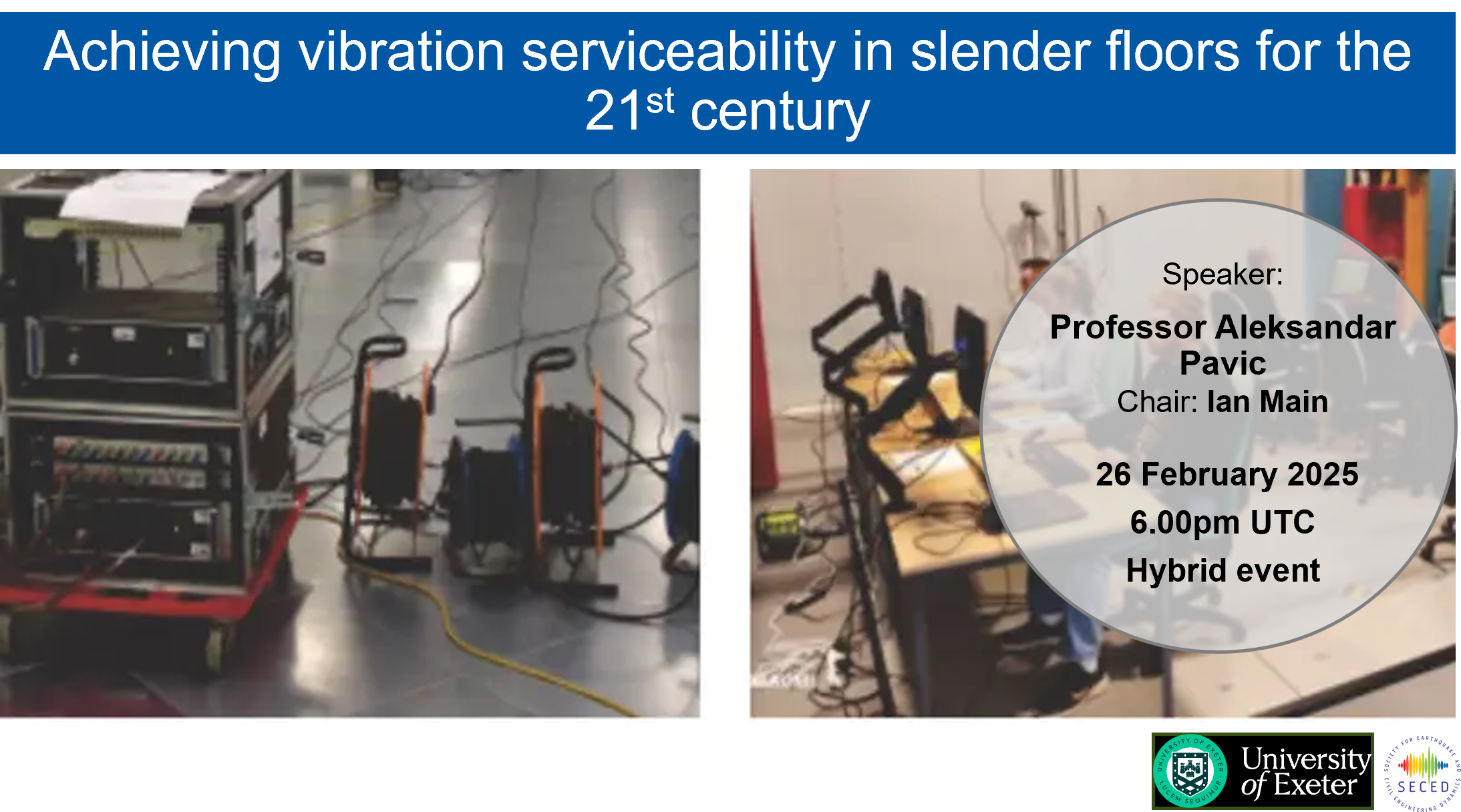Achieving vibration serviceability in slender floors for the 21st century
Synopsis
The UN states that the world needs to construct an additional 230 billion m² of building floors between 2020 and 2060. This represents a doubling of the current stock of building floors, equivalent to adding one city the size of Paris to the planet every week.
The vibration serviceability of building floors is critically important, as it has become the governing design criterion influencing their shape, size, and embodied carbon. Every vibration serviceability problem can be broken down into three components: vibration source, path, and receiver. There is considerable uncertainty associated with each of these sub-problems, with the vibration receiver being by far the least understood.
Historically, structural engineers designing buildings have addressed structural design uncertainties through the generous use of inexpensive construction materials, as no better approach existed.
However, in the context of the climate emergency and the need to eliminate material waste there is a need for radical re-thinking of the design process for vibration serviceability. This is particularly so considering the uncertainties that can render floor vibration design predictions unreliable or longer term even useless.
The following questions are therefore emerging:
- Are the current processes established in recognised floor vibration serviceability design guidelines for dealing with the vibration source, path and receiver fit for purpose?
- Can vibration control move away from adding normally disproportionally large amounts of structural mass and stiffness to reduce really tiny (a few microns) but still problematic vibrations?
To answer these questions, the talk will present an idea for a new framework for dealing with floor vibration serviceability that does not use mass and stiffness to control floor vibrations.
The framework is based on:
- More detailed consideration of realistic vibration serviceability design scenarios that make use of the latest developments pertinent to the vibration source, path and receiver. As to the least understood receiver: the early findings from and the need for and future application of the new VSimulator research facility in the UK to establish a new generation of vibration serviceability criteria for buildings. This is particularly crucial for understanding human perception of vertical vibration in building floors, which should be based on objectively measured cognitive performance rather than the currently dominant subjective assessment.
- Stopping structural modifications and replacing completely structural mass- and stiffness- with damping-based floor vibration control. Commercially available and usable in practice both passive and active vibration control products will be reviewed. In particular, CALMFLOOR® the new active mass damping technology - commercially launched in the UK and worldwide in 2022 - has the potential to be a game-changer. The mass-produced CALMFLOOR® mechatronics product allows designers to avoid both the excessive use of materials and significant structural modifications.
About the speaker
Professor Alex Pavic is an expert in the vibration serviceability of slender civil engineering structures, such as long-span floors, footbridges, and grandstands, which are used and dynamically excited by people.
He believes that the best laboratory is the real world, full of unique, full-scale prototypes of large civil engineering structures. Alex has built his parallel academic and professional consulting careers by modelling, testing, and monitoring full-scale footbridges, floors, grandstands, staircases, and other long and tall structures, using his understanding of how these structures behave in real-world conditions.
Trained as a structural engineer, Alex holds the Chair in Vibration Engineering and leads the Vibration Engineering Section research group, which moved to the University of Exeter in May 2013 after 20 years at the University of Sheffield.
He is the founder of the VSimulator research facility at the University of Exeter, a world-unique six-degree-of-freedom vibration simulator featuring the largest force plate in the world. This facility, developed between 2017 and 2022 at a cost of £7 million, enables groundbreaking research in vibration serviceability.
Alex’s contributions have been recognized in major state-of-the-art design guidelines in the UK and internationally:
- The Concrete Society (Technical Report 43, Appendix G: Vibration Serviceability of Post-Tensioned Concrete Floors, 2005),
- The Concrete Centre (A Design Guide for Footfall Induced Vibration of Structures, 2007), and
- The Steel Construction Institute (Design of Floors for Vibration: A New Approach, 2007).
He also co-authored and contributed to the experimental validation of the globally advanced design guidelines for crowd dynamic loading of grandstands, published by the Institution of Structural Engineers in 2008. Additionally, Aleksandar was a member of the International Standardisation Organisation (ISO) committee that developed ISO 10137, the key international standard for vibration serviceability of buildings.He currently serves as Technical Lead for building vibrations on the British Standards Institution (BSI) panel for "Human Exposure to Vibration and Shock" and represents the UK on the relevant ISO committee.
Alex’s expertise is highly valued in the industry. He is the Managing Director of Full Scale Dynamics Ltd, a university spin-off company specializing in the testing, monitoring and performance assessment of full-scale civil engineering structures since 2008.
He is also the founder and one of the directors of FSD Active Ltd, a 2020 start-up company that introduced CALMFLOOR®, the world first commercial active mass damping technology, to the market.
Join online
Please join the Zoom meeting by clicking on this link. No registration is required. Alternatively, join in-person at the event venue (see below).
Further information
This event is organised by SECED and chaired by Ian G. Smith (AtkinsRéalis). The event is open to all and is free to attend.
News: The recording of the event is accessible here: Achieving vibration serviceability in slender floors for the 21st century | Institution of Civil Engineers (ICE)
Event Details
| Event Date | 26/02/2025 6:00 pm |
| Event End Date | 26/02/2025 7:30 pm |
| Location | Institution of Civil Engineering - Godfrey Mitchell Theatre |
